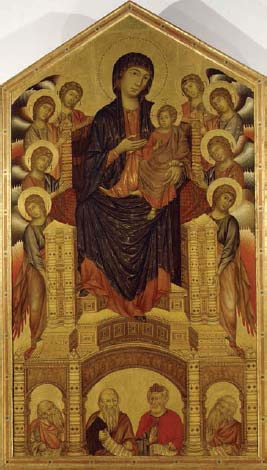The Early Modern World, C. 1300–1600Proto-Renaissance |
Who was Cimabue? |
In The Lives of the Artists, Giorgio Vasari describes the thirteenth-century artist Cimabue as the man who “shed the first light on the art of painting.” He is credited with innovations in naturalism; his art bridges the gap between the flat Byzantine style of painting and the more realistically proportioned style associated with the Renaissance. Comparing the work of Cimabue and his apprentice, Giotto, the difference is clear.
Cimabue’s panel painting, Virgin and Child Enthroned (c. 1280), depicts the Virgin Mary and Infant Christ surrounded by saints. The work is a blend of Gothic (Byzantine) style and newer Renaissance techniques: the folds of the drapery worn by the Virgin Mary are defined by gold lines. The figures of the saints are elongated and thin; Infant Christ appears to have the proportions of an adult. Despite the flatness and the stylized forms, Cimabue’s scene is warm and real. The figures are naturally proportioned and their faces are thoughtful, engaging, and diverse. Giotto’s painting of the same scene represents a major shift away from Gothic styles and towards more realistic images of figures and of three-dimensional space. The solid form of Mary’s body can be seen through her heavy, blue robes and the Infant Christ sits firmly upon her lap. The figures in Giotto’s Virgin and Child Enthroned are realistically modeled and Mary’s throne appears to extend back into real space.

The work of Florentine artist Cimabue represents a shift from Gothic to Renaissance painting styles. (Art courtesy The Art Archive / Galleria degli Uffizi Florence / Collection Dagli Orti.)
